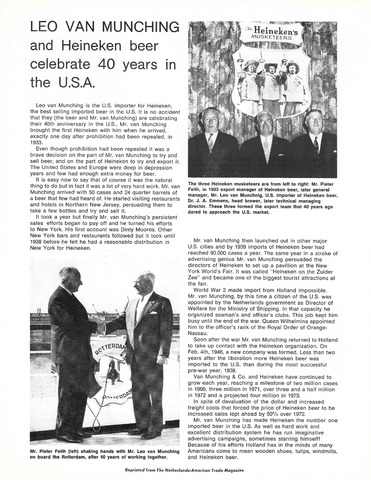m
LEO VAN MUNCHING
and Heineken beer
celebrate 40 years in
the U.S.A.
VïERO4
Heineken
Leo van Munching is the U.S. importer for Heineken,
the best selling imported beer in the U.S. It is no accident
that they (the beer and Mr. van Munching) are celebrating
their 40th anniversary in the U.S., Mr. van Munching
brought the first Heineken with him when he arrived,
exactly one day after prohibition had been repealed, in
1933.
Even though prohibition had been repealed it was a
brave decision on the part of Mr. van Munching to try and
sell beer, and on the part of Heineken to try and export it.
The United States and Europe were deep in depression
years and few had enough extra money for beer.
It is easy now to say that of course it was the natural
thing to do but in fact it was a lot of very hard work. Mr. van
Munching arrived with 50 cases and 24 quarter barrels of
a beer that few had heard of. He started visiting restaurants
and hotels in Northern New Jersey, persuading them to
take a few bottles and try and sell it.
It took a year but finally Mr. van Munching's persistent
sales efforts began to pay off and he turned his efforts
to New York. His first account was Dinty Moores. Other
New York bars and restaurants followed but it took until
1938 before he felt he had a reasonable distribution in
New York for Heineken.
ArtSJ
Mr. Pieter Feith (left) shaking hands with Mr. Leo van Munching
on board the Rotterdam, after 40 years of working together.
The three Heineken musketeers are from left to right: Mr. Pieter
Feith, in 1933 export manager of Heineken beer, later general
manager, Mr. Leo van Munchnig, U.S. importer of Heineken beer,
Dr. J. A. Emmens, head brewer, later technical managing
director. These three formed the export team that 40 years ago
dared to approach the U.S. market.
Mr. van Munching then launched out in other major
U.S. cities and by 1939 imports of Heineken beer had
reached 90,000 cases a year. The same year in a stroke of
advertising genius Mr. van Munching persuaded the
directors of Heineken to set up a pavillion at the New
York World's Fair. It was called "Heineken on the Zuider
Zee" and became one of the biggest tourist attractions at
the fair.
World War 2 made import from Holland impossible.
Mr. van Munching, by this time a citizen of the U.S. was
appointed by the Netherlands government as Director of
Welfare for the Ministry of Shipping. In that capacity he
organized seaman's and officer's clubs. This job kept him
busy until the end of the war. Queen Wilhelmina appointed
him to the officer's rank of the Royal Order of Orange-
Nassau.
Soon after the war Mr. van Munching returned to Holland
to take up contact with the Heineken organization. On
Feb. 4th, 1946, a new company was formed. Less than two
years after the liberation more Heineken beer was
imported to the U.S. than during the most successful
pre-war year, 1939.
Van Munching Co. and Heineken have continued to
grow each year, reaching a milestone of two million cases
in 1966, three million in 1971, over three and a half million
in 1972 and a projected four million in 1973.
In spite of devaluation of the dollar and increased
freight costs that forced the price of Heineken beer to be
increased sales lept ahead by 50% over 1972.
Mr. van Munching has made Heineken the number one
imported beer in the U.S. As well as hard work and
excellent distribution system he has run imaginative
advertising campaigns, sometimes starring himself!
Because of his efforts Holland has in the minds of many
Americans come to mean wooden shoes, tulips, windmills,
and Heineken beer.
Reprinted from The Nether/ands-American Trade Magazine

